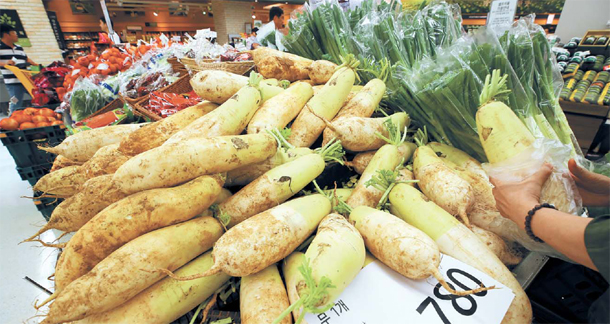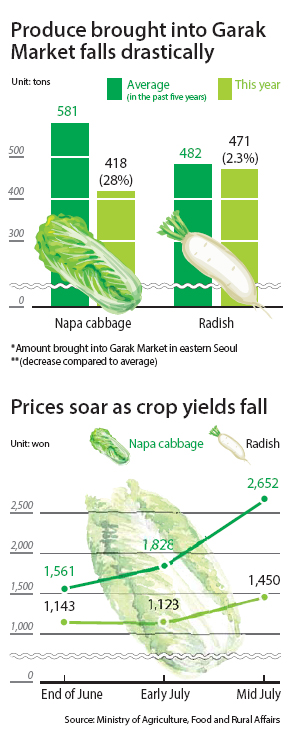Heat wave takes toll on veggies

Radishes sell for 1,780 won ($1.57) a piece at a supermarket in Seongdong District, eastern Seoul, on Monday. The prices of some crops, such as Napa cabbage and radishes, have increased recently due to a heat wave that came much earlier than expected, according to the Agriculture Ministry. [YONHAP]

“The heat wave that hit the country starting early this month has impaired the growing conditions of some crops,” explained Kim Jung-wook, director general of the marketing and consumer policy bureau of the Agriculture Ministry.
“The Korea Meteorological Administration thinks the weather will stay hot until the end of this month, which means the damage is likely to get worse.”
The Agriculture Ministry explained that crops such as Napa cabbage, which are mostly grown in mountainous regions of Gangwon that are 500 meters (1,640 feet) above sea level or higher, are suffering from various diseases, such as bacterial soft rot, due to the excessive heat that hit the farms immediately following the rains in late June and early July.
The data shows that the price of Napa cabbage went from 1,561 won ($1.38) a head at the end of June to 1,828 won at the beginning of this month to 2,652 won as of last weekend - an increase of about 70 percent in less than a month.
The price of radish jumped from 1,143 won to 1,450 won during the same period, up nearly 30 percent.
Compared to the average price for the past five years, the prices of Napa cabbage and radish each catapulted by 28 and 44 percent.
The drastic rise in prices is a result of declining supply of the crops, the Agricultural Ministry said.
At farms in the city of Taebaek in Gangwon, which are between 700 and 800 meters above sea level, yields of Napa cabbage fell by 20 percent compared to the same period last year.
Cabbage yields from farms more than 800 meters above sea level have yet to see notable declines, although the prolonged heat wave could also damage the yield from those farms, according to Kim.
The ministry explained that it will release about 100 to 150 tons of Napa cabbage per day until the end of this month from its reserves in order to stabilize the supply of the vegetable.
“Although the heat pushed up the prices of some vegetables, such as radish and Chinese cabbage, it has had a limited impact on the supply of other agricultural products so far,” said Kim. “But if the temperature stays as high as it has these days, it is likely that the supply of other agricultural products will become unstable.”
The unrelenting heat is also dealing a heavy blow to livestock.
As of Monday, 7,838 pigs and 1.12 million chickens were reported to have died due to the heat.
The price of chicken has been on the rise, going from 1,182 won per kilogram in June to 1,500 won as of last weekend. The average price of eggs also increased from 589 won per 10 eggs to 819 won, although their prices are still lower than the average of the past few years.
“The good news is that we had a decent amount of rain from January to June, making it possible for farmers to raise their crops without an additional water supply,” explained an official from the Agricultural Ministry when asked about the possibility of a drought.
“But if the weather continues to stay as dry as it is right now, we may run out of water in our reservoir, so we have to closely monitor the situation.”
BY CHOI HYUNG-JO [choi.hyungjo@joongang.co.kr]










with the Korea JoongAng Daily
To write comments, please log in to one of the accounts.
Standards Board Policy (0/250자)